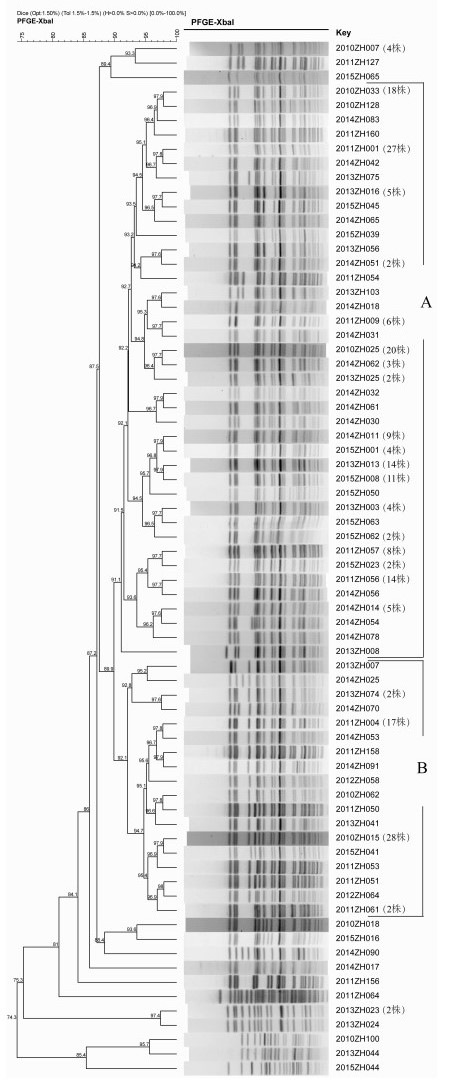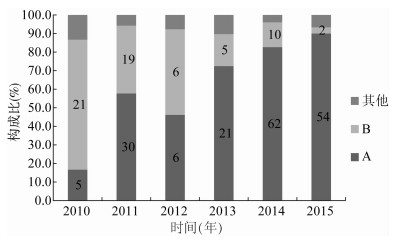扩展功能
文章信息
- 吕冰, 张新, 黄瑛, 霍达, 严寒秋, 王全意, 曲梅
- LYU Bing, ZHANG Xin, HUANG Ying, HUO Da, YAN Han-qiu, WANG Quan-yi, QU Mei
- 北京地区2010-2015年宋内志贺菌脉冲场凝胶电泳分型及耐药特征分析
- Pulsed field gel electrophoresis typing and drug resistance detection of Shigella sonnei isolated in Beijing, 2010-2015
- 疾病监测, 2016, 31(10): 870-874
- Disease Surveillance, 2016, 31(10): 870-874
- 10.3784/j.issn.1003-9961.2016.10.016
-
文章历史
- 收稿日期:2016-02-17
志贺菌是细菌性痢疾(菌痢)的病原菌,包括痢疾志贺菌、鲍氏志贺菌、福氏志贺菌和宋内志贺菌4群。人群普遍易感,严重影响人类健康。在发展中国家,菌痢是5岁以下儿童死亡的重要原因之一。在我国菌痢的发病也一直处于较高的水平。2005年8月卫生部发布了《全国细菌性痢疾监测方案》(试行),在10个省市的20个县(市)设立了国家监测点,北京市被列为监测点之一。通过近10年全市痢疾监测,宋内志贺菌已经成为北京市痢疾病原菌的优势菌株,并且其耐药率一直处于较高水平[1]。本研究收集了2010-2015年北京市痢疾监测分离到的259株宋内志贺菌,采用分子分型及药物敏感性试验等方法,了解北京市宋内志贺菌流行趋势及耐药情况。
1 材料与方法 1.1 菌株来源2010-2015年北京市痢疾监测中收集到的宋内志贺菌259株,所有菌株均分离自北京市肠道门诊的腹泻患者粪便标本。根据《国家霍乱痢疾监测方案北京实施办法》,全市16区均为监测点,每个监测点选取1~2家肠道门诊,每年4-10月完成患者粪便样本的检测,并上送分离到的病原菌。每年分离的菌株数见表 1。所有菌株经过法国生物梅里埃公司VITEK2-compact全自动微生物鉴定系统鉴定为志贺菌,并且经志贺菌检测血清(日本生研株式会社)进行血清型检测,确认为宋内志贺菌(生理盐水做对照)。
| 抗生素 | 2010年 (n=30) |
2011年 (n=52) |
2012年 (n=13) |
2013年 (n=27) |
2014年 (n=77) |
2015年 (n=60) |
合计 (n=259) |
P值 |
| AMP | 93.30 | 94.20 | 100.00 | 88.90 | 90.90 | 98.33 | 93.82 | |
| AUG | 93.30 | 92.30 | 100.00 | 88.90 | 61.00 | 95.00 | 83.70 | < 0.05 |
| CRO | 23.30 | 34.60 | 7.70 | 33.30 | 14.30 | 71.67 | 34.36 | < 0.05 |
| FEP | 3.30 | 5.80 | 0.00 | 11.10 | 0.00 | 13.33 | 5.79 | < 0.05 |
| FOX | 0.00 | 0.00 | 0.00 | 0.00 | 1.30 | 0.00 | 0.39 | |
| IMP | 0.00 | 0.00 | 0.00 | 0.00 | 0.00 | 0.00 | 0.00 | |
| TET | 50.00 | 38.50 | 23.10 | 48.10 | 92.20 | 86.67 | 66.41 | < 0.05 |
| NAL | 100.00 | 100.00 | 100.00 | 88.90 | 96.10 | 100.00 | 97.68 | |
| CIP | 6.70 | 1.90 | 0.00 | 0.00 | 2.60 | 0.00 | 1.93 | |
| SXT | 93.30 | 100.00 | 92.30 | 92.60 | 97.40 | 100.00 | 97.30 | |
| SUL | 93.30 | 100.00 | 92.30 | 96.30 | 97.40 | 98.33 | 97.30 | |
| CHL | 13.30 | 3.80 | 7.70 | 0.00 | 6.50 | 5.00 | 5.79 |
药敏试验用最小抑菌浓度(minimal inhibition concentration,MIC)法,使用革兰阴性需氧菌药敏检测板(上海星佰生物技术有限公司),药物应用氨苄西林(AMP)、阿莫西林-克拉维甲酸(AUG)、头孢曲松(CRO)、头孢吡肟(FEP)、头孢西丁(FOX)、亚胺培南(IMP)、四环素(TET)、萘啶酸(NAL)、环丙沙星(CIP)、复方新诺明(SXT)、磺胺异恶唑(SUL)和氯霉素(CHL)12种药物进行药物敏感性检测,其结果按照美国临床和实验室标准协会(Clinical and Laboratory Standards Institute,CLSI)发布的标准判定[2],以大肠埃希菌(ATCC25922)作为质控菌株。菌株的多耐药(MDR)、超耐药(XDR)及泛耐药(PDR)的判定参见2012年Magiorakos等[3]的著述。
1.3 脉冲场凝胶电泳(PFGE)参考美国疾病预防控制中心PulseNet实验方法[4],进行259株宋内志贺菌的PFGE分型。PFGE图像应用BioNumerics数据库软件进行处理,相似度系数设置为Dice(容许度设置为Opt:1.5%),采用UPGMA方法进行聚类分析并且绘制树状图。
1.4 统计学分析计算2010-2015年各年度每种药物的耐药率,并应用SPSS 21.0软件进行χ2检验,P < 0.05差异有统计学意义。
2 结果 2.1 药物敏感试验药物敏感性实验结果见表 1。在259株宋内志贺菌中,只有2株对所有药物敏感,其他257株为耐药菌株,其中245株为MDR,占95.33%(245/257)。259株宋内志贺菌中未发现XDR及PDR菌株。对AMP、NAL、SXT、SUL的耐药率均超过90%,对CRO、FEP和TET的各年度耐药率差异有统计学意义。所有的多耐药菌株均对NAL耐药,NAL-SUL-SXT-AMP-AUG-TET耐药模式占比例最大(29.8%);其次是NAL-SUL-SXT-AMP-AUG耐药模式,占21.22%;NAL-SUL-SXT-AMP-AUG-TET-CRO耐药模式,占20.00%,以及NAL-SUL-SXT-AMP-TET耐药模式,占7.35%;其余耐药模式所占比例<5.00%,不一一列举。
2.2 PFGE分型259株宋内志贺菌的PFGE分子分型结果经Bionumerics 5.0软件分析,绘制聚类图,见图 1。259株宋内志贺菌共分为72个PFGE带型,带型间相似度范围为98.0%~74.3%,有相同带型的菌株数量标注在菌株号右侧。根据以往的研究结果,带型相似度>90%的菌株可划分为一簇[5-6]。由图 1可见259株宋内志贺菌有A、B两个优势簇,A、B两簇的相似度约为89.9%。A簇菌株178株占总菌株数68.7%;B簇菌株63株,占24.3%(图 2)。由图 2可见2010-2015年A簇菌株逐年升高至90%,而B簇菌株逐年缩减。

|
| 图 1 259株宋内志贺菌PFGE分型结果 Figure 1 Dendrogram of PFGE subtyping of 259 Shigella sonnei strains |
| |

|
| 图 2 2010-2015年北京市259株宋内志贺菌A、B两簇的构成比 Figure 2 Proportion of cluster A and B in 259 Shigella sonnei isolates, 2010-2015, Beijing 注:图中的数字表示该年度菌株中A、B两簇各占的菌株数。 |
| |
表 2比较了A、B两簇菌株对12种药物的药物敏感性实验结果,AUG、CRO和TET三种药物耐药率差异有统计学意义,A簇菌株对CRO和TET的耐药率明显高于B簇,而B簇对AUG的耐药率高于A簇。
| 药物 | A组耐药菌(%) | B组耐药菌(%) | P值 |
| AMP | 95.45 | 98.31 | |
| AUG | 81.82 | 94.92 | < 0.05 |
| CRO | 39.77 | 18.64 | < 0.05 |
| FEP | 6.82 | 3.39 | |
| FOX | 0.57 | 0.00 | |
| IMP | 0.00 | 0.00 | |
| TET | 72.73 | 49.15 | < 0.05 |
| NAL | 98.86 | 100.00 | |
| CIP | 1.14 | 0.00 | |
| SXT | 99.43 | 100.00 | |
| SUL | 98.86 | 100.00 | |
| CHL | 4.55 | 5.08 |
发达国家细菌性痢疾的病原体以宋内志贺菌占优势[7],而发展中国家一直以福氏志贺菌为主,但近年来宋内志贺菌在发展中国家的感染率有增高的趋势[8]。根据北京市以往的研究,从2009年后宋内志贺菌已成为北京地区的优势菌株[1, 9]。同痢疾志贺菌、福氏志贺菌相比,感染宋内志贺菌通常发病较温和,更容易在人群中播散[10]。北京地区人口多,人口密度相对集中,人员流动性比较大,宋内志贺菌的远距离播散也成为可能。根据本研究的结果,北京地区宋内志贺菌有A、B两簇优势菌株,但是两簇菌株PFGE图谱在树状图中计算的相似度比较高(89.9%), 存在较高的同源性。在以往的工作中,志贺菌多位点序列分析(multilocus sequence typing system,MLST)结果也得出相似的结论[11]。按照年度菌株分布来看A簇菌株逐年增多,到2015年A簇菌株达到90%以上,宋内志贺菌A簇已经成为目前北京地区宋内志贺菌的优势簇。虽然近年没有志贺菌感染集中暴发的事件,但是志贺菌的持续播散,也使得加强志贺菌分子流行病监测,了解流行趋势、控制疾病的传播具有重要的意义。
治疗菌痢的原则之一是正确合理选用抗生素,磺胺类药物和喹诺酮类药物是治疗菌痢的常用药,然而使用抗生素虽然对减轻临床症状、缩短病程有重要作用,同时也带来了病原菌耐药性增高的问题。据报道1998-2009年亚洲和非洲志贺菌对NAL和CIP的耐药率分别从33.6%和5.0%上升到64.5%和29.1%[12]。根据1990-2007年北京地区宋内志贺菌耐药性监测,CIP和氧氟沙星的耐药率无明显增长,而磺胺类药物、AMP和CRO耐药率有明显增高[13-14],本次研究结果显示AMP及磺胺类药物耐药率已经超过95%,更为严重的是对CRO以及FEP快速增长的耐药率。近年来宋内志贺菌耐三代头孢菌素或产超广谱3-内酰胺酶的报告增多[15-18],对β-内酰胺类药物包括AMP、哌拉西林、头孢噻肟及CRO耐药增加趋势明显,超过亚洲其他国家的监测数据和增长速度[19]。2009年鲍春梅等[20]已经发现宋内志贺菌在北京地区对三代头孢类药物的耐药率已达到73.3%,本研究也有相近的结果。可能和临床上大量应用三代头孢作为治疗首选药物有关。宋内志贺菌A、B两簇菌株对三代头孢类药物(CRO)的耐药率差异有统计学意义,A簇菌株的耐药率明显高于B簇。按照年度分布A簇菌株逐年增多,到2015年已高于90%,所以宋内志贺菌菌株A、B两簇的分布变化也是耐药率增高的重要原因。
根据2005年全国监测点的数据[21],常见耐药谱AMP、NAL、TET、SXT耐药占17.2%;AMP、阿莫西林/克拉维酸、NAL、TET、SXT耐药占15%。而本研究中显示在2010年后多耐药率升高,耐药谱的情况也更加复杂,提示合理应用抗生素的必要性。
作者贡献:吕冰:菌株分型结果分析及论文撰写
张新、黄瑛:菌株分子分型及生化分析
霍达:数据分析
严寒秋:志贺菌株的血清分析
王全意、曲梅:实验设计及数据分析
| [1] | Qu M, Zhang X, Liu GR, et al. An eight-year study of Shigella species in Beijing, China:serodiversity, virulence genes, and antimicrobial resistance[J]. J Infect Dev Ctries , 2014, 8 (7) : 904–908. |
| [2] | Clinical and Laboratory Standards Institute. Performance standards for antimicrobial susceptibility testing; M100S 26th ed[S]. Wayne, PA:CLSI. |
| [3] | Magiorakos AP, Srinivasan A, Carey RB, et al. Multidrug-resistant, extensively drug-resistant and pandrug-resistant bacteria:an international expert proposal for interim standard definitions for acquired resistance[J]. Clin Microbiol Infect , 2012, 18 (3) : 268–281. DOI:10.1111/j.1469-0691.2011.03570.x |
| [4] | Standard Operating Procedure for PulseNet PFGE of Escherichia coli O157:H7, Escherichia coli non-O157(STEC), Salmonella serotypes, Shigella sonnei and Shigella flexneri[S]. 2013. http://www.cdc.gov/pulsenet/pathogens/pfge.html |
| [5] | Calvez S, Fournel C, Douet DG, et al. Pulsed-field gel electrophoresis and multi locus sequence typing for characterizing genotype variability of Yersinia ruckeri isolated from farmed fish in France[J]. Vet Res , 2015, 46 : 73. DOI:10.1186/s13567-015-0200-5 |
| [6] | Tenover FC, Arbeit RD, Goering RV, et al. Interpreting chromosomal DNA restriction patterns produced by pulsed-field gel electrophoresis:criteria for bacterial strain typing[J]. J Clin Microbiol , 1995, 33 (9) : 2233–2239. |
| [7] | Sivapalasingam S, Nelson JM, Joyce K, et al. High prevalence of antimicrobial resistance among Shigella isolates in the United States tested by the National Antimicrobial Resistance Monitoring System from 1999 to 2002[J]. Antimicrob Agents Chemother , 2006, 50 (1) : 49–54. DOI:10.1128/AAC.50.1.49-54.2006 |
| [8] | Chang ZL, Lu ST, Chen LH, et al. Causative species and serotypes of shigellosis in mainland China:Systematic review and meta-analysis[J]. PLoS One , 2012, 7 (12) : e52515. DOI:10.1371/journal.pone.0052515 |
| [9] | Qu M, Liu GR, Zhang X, et al. Distribution of different serotypes and analysis of virulence genes in Shigella species in Beijing from 2004 to 2010[J]. Chinese Journal of Health Laboratory Technology , 2011, 21 (8) : 1850–1853. (in Chinese) 曲梅, 刘桂荣, 张新, 等. 北京市2004-2010年志贺菌菌型分布及毒力基因分析[J]. 中国卫生检验杂志 , 2011, 21 (8) : 1850–1853. |
| [10] | World Health Organization. Guidelines for the control of shigellosis, including epidemics due to Shigella dysenteriae type 1[M]. Geneva, Switzerland: WHO, 2005 . |
| [11] | Liu GR, Qu M, Zhang X, et al. Molecular epidemiological characteristics of Shigella sonnei isolates in Beijing[J]. China Tropical Medicine , 2013, 13 (8) : 950–952, 963. (in Chinese) 刘桂荣, 曲梅, 张新, 等. 北京地区宋内志贺菌分子流行病学特征分析[J]. 中国热带医学 , 2013, 13 (8) : 950–952, 963. |
| [12] | Gu B, Cao Y, Pan SY, et al. Comparison of the prevalence and changing resistance to nalidixic acid and ciprofloxacin of Shigella between Europe-America and Asia-Africa from 1998 to 2009[J]. Int J Antimicrob Agents , 2012, 40 (1) : 9–17. DOI:10.1016/j.ijantimicag.2012.02.005 |
| [13] | Bao CM, Cui EB, Guo TS, et al. Drug resistance and ESBLs producing in 1831Shigella sonnei strains[J]. Infectious Disease Information , 2009, 22 (3) : 143–146. (in Chinese) 鲍春梅, 崔恩博, 郭桐生, 等. 1831株宋内志贺菌耐药性调查及其产ESBLs的研究[J]. 传染病信息 , 2009, 22 (3) : 143–146. |
| [14] | Qu F, Ban CM, Chen SM, et al. Genotypes and antimicrobial profiles of Shigella sonnei isolates from diarrheal patients circulating in Beijing between 2002 and 2007[J]. Diagn Microbiol Infect Dis , 2012, 74 (2) : 166–170. DOI:10.1016/j.diagmicrobio.2012.06.026 |
| [15] | Acikgoz ZC, Eser OK, Kocagöz S. CTX-M-3 type beta-lactamase producing Shigella sonnei isolates from pediatric bacillary dysentery cases[J]. Jpn J Infect Dis , 2008, 61 (2) : 135–137. |
| [16] | Hrabák J, Empel J, Gniadkowski M, et al. CTX-M-15-producing Shigella sonnei strain from a Czech patient who traveled in Asia[J]. J Clin Microbiol , 2008, 46 (6) : 2147–2148. DOI:10.1128/JCM.00427-08 |
| [17] | Nagano Y, Nagano N, Wachino J, et al. Novel chimeric β-lactamase CTX-M-64, a hybrid of CTX-M-15-like and CTX-M-14β-lactamases, found in a Shigella sonnei strain resistant to various oxyimino-cephalosporins, including ceftazidime[J]. Antimicrob Agents Chemother , 2009, 53 (1) : 69–74. DOI:10.1128/AAC.00227-08 |
| [18] | Cheung TKM, Chu YW, Tsang GKL, et al. Emergence of CTXM-type β-lactam resistance in Shigella spp. in Hong Kong[J]. Int J Antimicrob Agents , 2005, 25 (4) : 350–352. DOI:10.1016/j.ijantimicag.2005.01.007 |
| [19] | Kuo CY, Su LH, Perera J, et al. Antimicrobial susceptibility of Shigella isolates in eight Asian countries, 2001-2004[J]. J Microbiol Immunol Infect , 2008, 41 (2) : 107–111. |
| [20] | Bao CM, Chen SM, Guo TS, et al. Epidemic tendency and clone transimission of insensitive Shigella sonnei against third generation cephalosporin[J]. Chinese Journal of Antibiotics , 2009, 34 (10) : 617–620. (in Chinese) 鲍春梅, 陈素明, 郭桐生, 等. 对三代头孢菌素不敏感宋内志贺菌的流行趋势和克隆传播[J]. 中国抗生素杂志 , 2009, 34 (10) : 617–620. |
| [21] | Yu HL, Chang ZR, Zhang LS, et al. Analysis on the status of Shigella spp. antimicrobial resistance through data from the National Shigellosis Surveillance System in China, in 2005[J]. Chinese Journal of Epidemiology , 2007, 28 (4) : 370–373. (in Chinese) 余华丽, 常昭瑞, 张立实, 等. 国家监测点2005年志贺菌菌型分布和药敏结果分析[J]. 中华流行病学杂志 , 2007, 28 (4) : 370–373. |
 2016, Vol. 31
2016, Vol. 31


